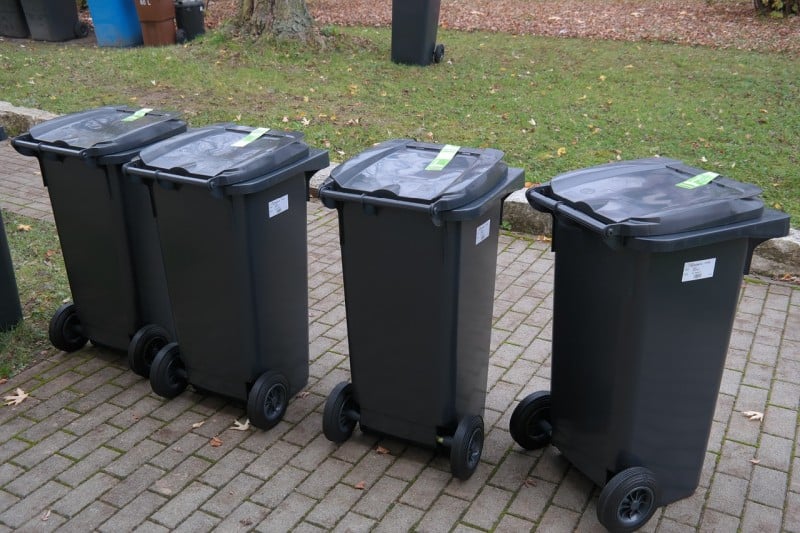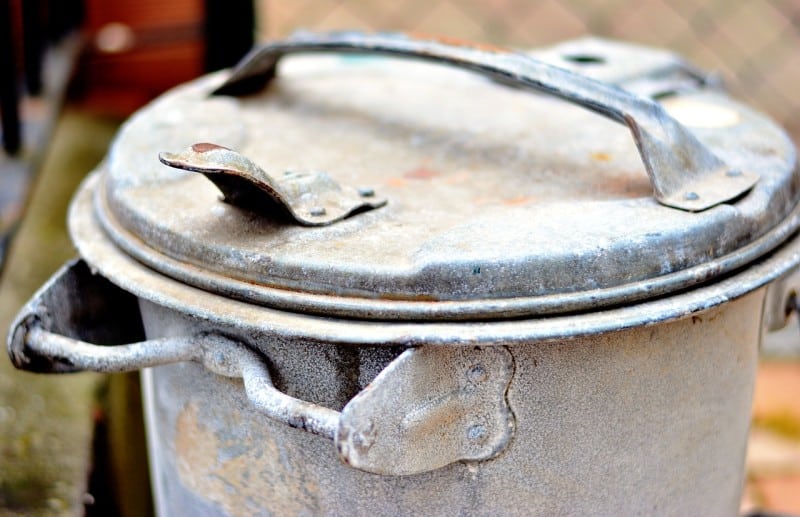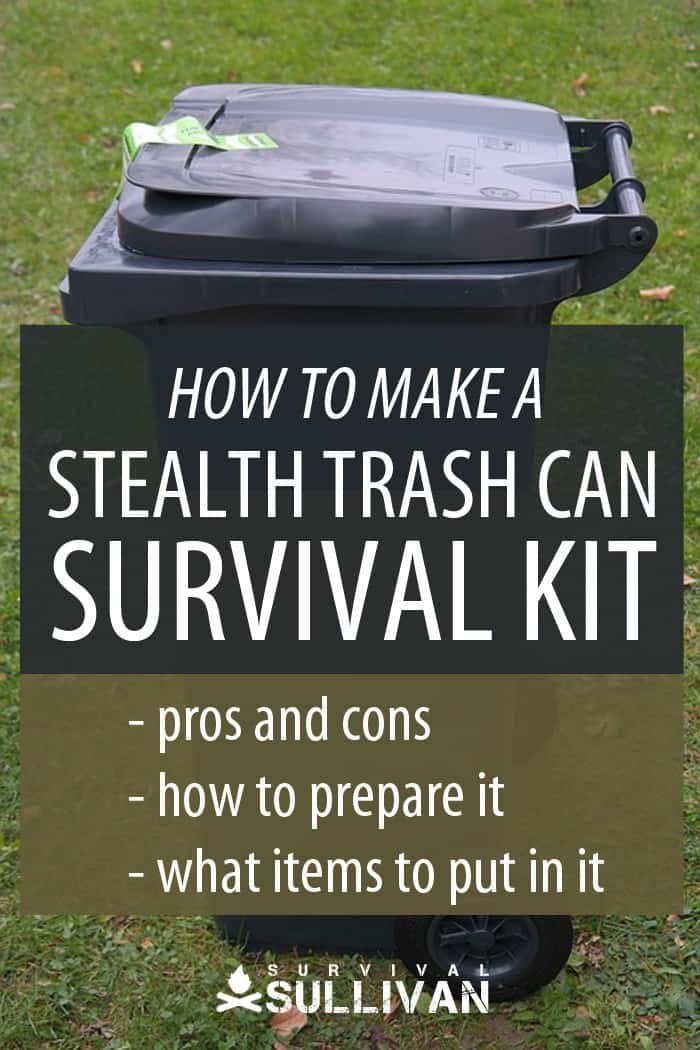How to Make a Stealth Trash Can Survival Kit
There are all kinds of ways to go about making a survival kit for you and your family or group. You can have kits in bags, kits on shelves, kits in tubs and kits in crates. One kit Ill bet you have never considered is a survival kit in a trash can!
No, your dear author, Tom, here, has not rounded the bend into dementia; for certain preppers, a trash can kit makes sense, and can let you keep all of your preps in one convenient, durable and discreet container that most people will overlook.

Like any other packing configuration, trash can kits are not without their drawbacks, but you can say the same for any kind of kit. Done properly, your trash can survival kit will serve as your ready resupply point and a perfect SHTF water basin all in one.
Read on to get all the details.
Why a Trash Can, Tom?
As odd as it sounds, the right trash can has many traits to commend it as a storage container, and for things besides trash! Modern plastic trash cans can be had in a variety of sizes, are extremely durable, have conveniently places handles and most often have a lid that snaps or latches securely enough to keep rodents, dust and other undesirables out of your goodies.
Trash cans are not, as a rule, watertight (keeping water out if submerged) but they will keep the bulk of rain and moisture out if their lids are sealed.
Most importantly, you can use a clean trash can to hold a considerable amount of collected water when you are camping at your BOL or just making a stop for a time.
As I said above, trash cans have a certain amount of stealth built in to them. In most contexts, people wont give a trash can, any trash can, a second glance.
They just hold garbage after all! With a little ingenuity and set dressing it is possible to hide all kinds of things in plain sight, safe in the knowledge that all but the most thorough or cunning minds will ever give it more than a glance before moving on.
Just as importantly, trash cans are available anywhere and can be had affordably in all kinds of sizes, shapes, colors and configurations. This makes them an economical and easy choice for those who dont want to spend the time or coin assembling an array of specialty containers or amassing a collection of common plastic bins to be loaded and handled individually.
Drawbacks
Trashcans are not without shortcomings, however. The most obvious one is youll have a bunch of your prepping eggs in one prepping basket. This is not to say you shouldnt: if you have all your eggs in one basket, you just keep a close on that basket, not five or ten different baskets.
But if something compromises your big trashcan survival kit you are likely going to lose much of the contents unless you have compartmented your stuff in sealed baggies additionally.
Youll also be at the mercy of the combined total weight of your trashcan survival kit. A full-size generic trashcan can hold a ton of stuff, and if you load it with water (which is extremely heavy by volume) canned food and all kinds of other stuff from clothes and tools to shelter gear and medical supplies youll be talking easily a hundred pounds to lift drag and hoist.
As part of a team effort, this might not be a big deal, but trash cans are not particularly foot mobile, and nor were they designed to be moved for any distance even by teams of people.
Sure, you can get one with some dinky built-in wheels, but these are not likely to work well under the load youll typically be subjecting the can to.
Ultimately, trash can survival kits are at their best when you plan to shelter in place, or have people to help you load it in the back of a truck or similar vehicle if you plan to bug out. For solo preppers hitting the road, they are less than ideal.
Packing Your Trashcan Survival Kit
A few ground rules when packing your trashcan kit. In general, when packing something like a BOB, youll have a little more flexibility since your overall weight will be much lower and some items get preference in case you need to access them in a hurry.
In a trashcan survival kit however, youll need to pay particular attention to where you locate the heavier items, since toppling is an issue of concern and youll also need to be mindful of crushing more fragile items!
If you have a certain loadout already laid out, get a course idea of how much volume it will consume and then pick your can accordingly. More volume is always an invitation to load more, and you can avoid the temptation to load more than is needed and thereby uselessly increasing weight.
Things like water, canned food and so on should go at or near the bottom of the can, for stability and comparative ease of carry. Lighter things like clothing can be left on top or distributed throughout the can as padding. Anything which you might need the most in an emergency, like flashlights, can be left on or right near the top.
Check the weight of your trashcan as you load it. You dont want to get it filled up and then find out it is too heavy to move! If you are using your can for fixed site, bug-in storage and preparation, make sure you pre-locate it before you start to load it.
Trashcan Specifics
Youll want to buy a trashcan for this purpose that is on the heavy duty side. Plenty of large trashcans are nonetheless made from flimsy plastic and have wimpy handles that can potentially tear or break if you and a pal try to hoist a heavily-laden one.
Also be sure to find a model with a lid that snaps or latches securely to the body. It does not have to seal tightly (you can always improve that DIY with various kits and materials) but it should be snug and fitted enough to keep inquisitive rodents out.
Dont get anything besides one of the heavy gauge, rubberized sort of plastic cans: metal is too easy to dent and warp, and if it isnt it is one heavy beast!
Lastly and just as importantly, take the time to locate and procure appropriate water-grade liners. I do not know if your average can or will leach chemicals into water you store in it, and I further dont know if those chemicals are harmful in the short term, but dont take any chances over so small a thing.

Camouflaging your Can
Whatever kind of can you get and wherever you place it, take the time and little bit of extra effort to distress it so it does not look like a bright and shiny new can.
Youd be surprised what seemingly innocuous and out of place things will tip people off that something does not fit in the environment.
There a hundred ways to do this depending on how exactly you want to place the can, but a few tried and true methods for weathering work wonders here.
The only ground rule you should worry about is taking care that you do not unnecessarily contaminate the inside of the can. We want that part to stay cherry and clean, and if someone should look inside the jig is up anyway unless you rig up some kind of false topper that looks like trash or junk (not a bad idea).
Here is a short list of weathering techniques that are totally DIY, fast and painless.
- Scrape it up! Trash cans get dragged around plenty, tipped over often, and manhandled by men and machines both and their exteriors reflect this fact. You can scuff your can up good and proper by dragging around across your driveway or other rough surface, whacking it against or with hard corners, knocking it over randomly a few times and other similar methods.
- Make it grubby! Trashcans that live outside or in workshops rarely if ever get cleaned. Theyll often be covered in a patina of miscellaneous grime, spattered with various substances like paint, glue and woodstain, and marked and marred by various other substances. A conservative drizzle of paint or stain here and there is a good idea.
- Age it! One trick well known to fullsize prop makers and modelers is the grimy aging power of simple, plain coffee. You can take a rag lightly soaked with coffee and give your can a good wash before leaving it to dry. This will further age the dried paint applied in the previous step, and really sell the illusion that the can has been there for a while.
What Should You Put in Your Trashcan Survival Kit?
The contents of your new kit should be much the same as any other SHTF preppers kit, with a few modifications. As always, your kit should be stored in a place where it is reasonably protected from the elements, and make sure that any items with special storage and keeping requirements have them met!
Water
Water is always an essential prep. Dehydration will debilitate and kill you faster than nearly anything else, so youll always want a certain, ready supply of drinking water in bottles or jugs at the minimum.
This is likely the item that will go on the very bottom of the can, making it something of a pain to access to rotate it or drink it, but you are ill advised to set it any higher up in the stack; if it leaks, it can destroy much of what is below it.
You want at least a gallon per person per day to be on the safe side. Also be sure to toss in some easy to use water filters like the Life Straw.
Shelter
Exposure is one of the things likely to kill you quicker than dehydration in a crisis. If conditions are ideally terrible, you can die from exposure in a matter of hours.
Ensure you have an answer for cold and wet conditions, as well as something to provide shade if you live in a hot environment. Blankets, emergency space blankets, tarps and even compact tents are all good options.
Food
Most people can live for a good long while with no additional food thanks to the prodigious spare tanks we have around our midsections, but a lack of calories will reduce energy for work, make it harder to think fast and clearly, and definitely make everyone surly; food is a big morale booster!
Youll definitely want food in your survival kit, averaging 2200 calories a day for an adult, though you can always stretch this by rationing. Your options for storing food include bulk staples like rice, flour, honey, etc. or ready-to-eat options like MREs, canned and foil packed food.
The trick with trashcan kit storage is locating it: food ideally goes near the bottom since it is heavy, but it is also the thing youll need to rotate most often, meaning it should be closer to the top. Use your own judgment based on your selections.
Clothing
You want at least a single change of clothes in your kit, preferably durable, quick drying fabrics that are suitable for work or travel. Dont forget the underwear and socks!
You can also include things like heavy footwear (boots or trails shoes), gloves, hats and similar situationally specific items for season or activity.

Light
Flashlights, headlamps, lanterns and candles rule the roost for providing light in emergencies. All have merits, but you should be relying on flashlights and headlamps for work and general purpose lighting as they combine the lowest risk with the most output.
They of course need batteries, and you should include those in abundance within your trashcan kit. Dont forget batteries need rotation, too!
Alternative light sources could be candles, which can also provide a little heat and some cooking utility and chemlights, those snapable, glow in the dark wands you see around Halloween.
Those are more situationally useful, but require no extraneous object or tool to activate and are utterly safe. They are great for marking and providing soft lighting at night.
Tools
A selection of simple tools like duct tape, cord, vise-grips, a claw hammer, a handsaw and a good multitool should be included in your kit so you have the ability make simple repairs and build what simple structures you need in the wake of an emergency. A few boxes of nails and screws arent a bad idea either.
Medical
Youll need the skills and the know-how to make use of anything more complicated than a band-aid, but medical equipment should be near the top of your checklist and near the very top of your kit.
A good medical kit will include comprehensive items for trauma of all kinds- lacerating or penetrating wounds, broken bones, burns, head trauma, etc.- and also less exciting items for common scrapes, cuts, bites, blisters and ailments of all kinds.
If you require any prescription meds or prescription eyewear, include them as well. Dont forget to rotate your meds, and also to keep your items in waterproof containers, like showcased below:

Weapons
Youll need something to defend yourself and your mates with. This can be a knife or other tool pressed into service as a weapon, or a firearm. I would strongly recommend you keep a gun in more secure storage or on you and stash extra ammo in the kit if a firearm is your weapon of choice.
In the case of a tool, an axe, hatchet or crowbar can serve multiple purposes aside from cracking or cleaving heads. A baseball bat is a trusty American standby but not designed for the rigors of combat and will break down fairly quickly compared to a purpose made club.
Bug Out Bag
If you are keeping a trashcan survival kit you should at least keep a backpack at the ready in case you do need to hit the road at a moments notice.
Your pack can be, er, packed flat and stashed in the can with very little cost to room or weight and provides you an excellent backup option for bugging out. A good pack will be sturdy and comfy to carry for longer distances.
A good prepper will have tested this pack by checking to see it can carry everything he wants, and also how it holds up and treats their body after a long hike.
Conclusion
A trash can survival kit is a quirky but useful and accessible way to store your SHTF emergency supplies, with the added benefits of hide-in-plain sight concealment and water storage ability.
Chosen with care and emplaced smartly, you will hardly need to give a care about the contents safety as most folks will avoid trashcans if they are able. Consider how one of these interesting preparedness kits will work for your plan!

The post How to Make a Stealth Trash Can Survival Kit appeared first on Survival Sullivan.
